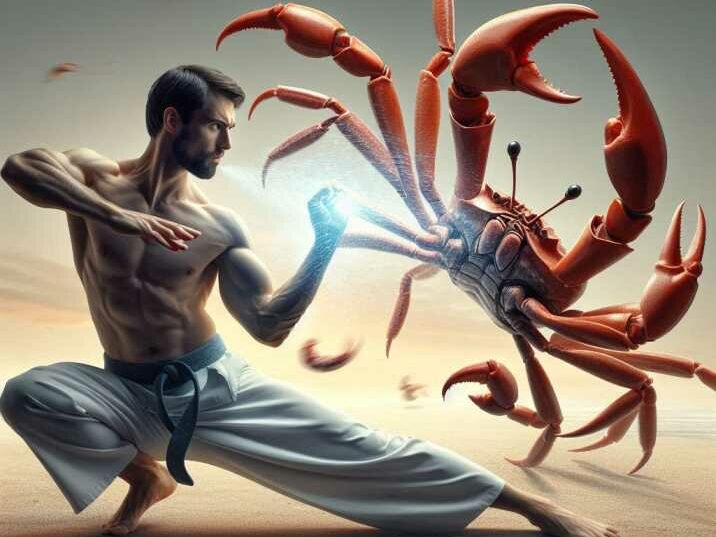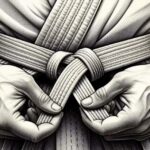Exploring the Fascinating World of Crab-Inspired Martial Arts
Table of Contents
Table of Contents
- Introduction
- Overview of Crab-Inspired Martial Arts
- Purpose and Scope of the Article
- The Concept of Animal-Inspired Martial Arts
- Historical Background
- Rationale Behind Crab-Inspired Martial Arts
- Historical References and Modern Interpretations
- Historical References
- Modern Interpretations
- Techniques and Principles of Crab-Inspired Martial Arts
- Core Principles
- Defense First
- Lateral Movement
- Gripping and Controlling
- Key Techniques
- Side Step Maneuver
- Pincer Grip
- Shell Defense
- Lateral Strike
- Core Principles
- Training and Practice
- Physical Conditioning
- Strength Training
- Agility Drills
- Flexibility Exercises
- Technique Drills
- Side Step Drills
- Pincer Grip Drills
- Combination Drills
- Physical Conditioning
- The Benefits of Crab-Inspired Martial Arts
- Physical Benefits
- Improved Agility
- Increased Strength
- Enhanced Balance
- Mental Benefits
- Strategic Thinking
- Increased Focus
- Stress Relief
- Physical Benefits
- Conclusion
- Summary of Key Points
- Encouragement to Explore Crab-Inspired Martial Arts
- FAQs
Introduction
Welcome to an intriguing exploration of the unique and captivating world of martial arts inspired by one of nature’s most resilient creatures: the crab. Martial arts have always drawn inspiration from animals, with styles like Tiger, Crane, and Monkey becoming household names in the martial arts community. However, the notion of a martial art based on the crab piques my curiosity and imagination. In this blog post, we will delve deep into the existence of crab-inspired martial arts and principles of martial arts that take cues from the crab.
We will explore historical references, modern interpretations, and the fascinating techniques that embody the crab’s defensive and combative prowess. Whether you are a martial arts enthusiast, a curious reader, or someone looking to expand your knowledge, this comprehensive guide promises to deliver insights and detailed information that is both engaging and informative.

The Concept of Animal-Inspired Martial Arts
Animal-inspired martial arts have a long-standing tradition in many cultures, particularly in Asia. These styles are characterized by mimicking the movements, strategies, and physical attributes of animals. The purpose behind this mimicry is to harness the unique strengths and abilities of these animals, thereby enhancing the effectiveness of human combat techniques.
Historical Background
The origins of animal-inspired martial arts can be traced back to ancient China, where Shaolin monks observed animals to develop their combat techniques. Each animal-based style was designed to incorporate the specific traits of the animal it was based on. For example, the Tiger style emphasizes powerful strikes and aggressive movements, while the Crane style focuses on balance and precision.
The Rationale Behind Crab-Inspired Martial Arts
Crabs, with their hard exoskeletons, powerful pincers, and unique sideways movement, present a fascinating model for martial arts. Their ability to defend themselves and their strategic use of their environment make them an interesting subject for martial art development. The concept of crab-inspired martial arts revolves around these key characteristics: defense, lateral movement, and the use of pincers or gripping techniques.
Historical References and Modern Interpretations
Historical References
While there is limited historical documentation specifically dedicated to crab-based martial arts, elements of crab-like techniques can be found in various traditional martial arts styles. For example, the Southern Praying Mantis style of Kung Fu incorporates movements that resemble the defensive and offensive strategies of a crab. Additionally, certain techniques in Brazilian Jiu-Jitsu and Judo involve gripping and controlling the opponent in a manner reminiscent of a crab’s pincers.
Modern Interpretations
In recent years, there has been a growing interest in developing and formalizing crab-inspired martial arts. Martial artists and practitioners have started to experiment with integrating crab-like movements and strategies into their training. This has led to the emergence of new styles and techniques that explicitly draw inspiration from the crab.One notable example is the development of a style known as “Crab Kung Fu,” which emphasizes lateral movement, defensive postures, and gripping techniques. Practitioners of Crab Kung Fu train to mimic the crab’s movements, focusing on agility, balance, and the ability to control and subdue opponents using techniques inspired by the crab’s pincers.
Techniques and Principles of Crab-Inspired Martial Arts
Core Principles
- Defense First: Crabs are known for their strong defensive capabilities, thanks to their hard exoskeletons. Similarly, crab-inspired martial arts prioritize defense, teaching practitioners to protect themselves effectively while waiting for the right moment to counterattack.
- Lateral Movement: Crabs move sideways with remarkable agility. In crab-inspired martial arts, practitioners are trained to move laterally, which can confuse opponents and create opportunities for attack or escape.
- Gripping and Controlling: The pincers of a crab are powerful tools for gripping and immobilizing prey. Techniques in crab-inspired martial arts often involve gripping, locking, and controlling the opponent, making it difficult for them to escape or counterattack.

Key Techniques
- Side Step Maneuver: This technique involves moving sideways to avoid an attack, similar to how a crab moves. It allows the practitioner to maintain a defensive stance while positioning themselves for a counterattack.
- Pincer Grip: Inspired by the crab’s pincers, this technique involves using the hands to grip and control the opponent’s limbs or body. It can be used to immobilize or manipulate the opponent into a vulnerable position.
- Shell Defense: Drawing inspiration from the crab’s hard exoskeleton, this technique focuses on using the body’s natural defenses to absorb and deflect attacks. This can involve positioning the arms and legs to protect vital areas and minimize damage from strikes.
- Lateral Strike: This technique involves delivering strikes while moving sideways, taking advantage of the element of surprise and the opponent’s unguarded angles.
Training and Practice
Physical Conditioning
To effectively practice crab-inspired martial arts, practitioners must develop a high level of physical conditioning. This includes:
- Strength Training: Building the strength necessary to execute powerful gripping and controlling techniques.
- Agility Drills: Enhancing lateral movement and the ability to quickly change direction.
- Flexibility Exercises: Ensuring the body can move fluidly and maintain balance during complex maneuvers.
Technique Drills
Training in crab-inspired martial arts involves repetitive practice of key techniques to build muscle memory and proficiency. Common drills include:
- Side Step Drills: Practicing lateral movement to evade attacks and create openings.
- Pincer Grip Drills: Developing the ability to grip and control the opponent effectively.
- Combination Drills: Integrating different techniques into fluid sequences to simulate real combat situations.
The Benefits of Crab-Inspired Martial Arts
Physical Benefits
- Improved Agility: The emphasis on lateral movement enhances overall agility and coordination.
- Increased Strength: The focus on gripping and controlling techniques builds upper body and core strength.
- Enhanced Balance: The need to maintain a stable stance during lateral movement improves balance and stability.
Mental Benefits
- Strategic Thinking: Practitioners learn to think strategically, anticipating and countering their opponent’s moves.
- Increased Focus: The precise nature of crab-inspired techniques requires concentration and mental clarity.
- Stress Relief: The physical activity and focus required in training provide an effective outlet for stress and tension.
Conclusion
The concept of a martial art based on the crab is a fascinating and unique addition to the world of animal-inspired martial arts. By drawing on the crab’s defensive capabilities, lateral movement, and gripping techniques, practitioners can develop a distinctive and effective style of combat. Whether you are a seasoned martial artist or a curious beginner, exploring crab-inspired martial arts offers a new perspective on the art of self-defense.We hope this comprehensive guide has provided you with valuable insights into the world of crab-inspired martial arts.
If you are interested in learning more or getting started with training, there are numerous resources and schools available to help you on your journey. Embrace the crab’s resilience and adaptability, and discover the exciting possibilities of this unique martial art.
FAQs
- What is crab-inspired martial arts?
- Crab-inspired martial arts is a style that mimics the movements, defense mechanisms, and gripping techniques of crabs. It focuses on lateral movement, strong defense, and powerful gripping or controlling maneuvers.
- Are there historical references to crab-inspired martial arts?
- While there are limited direct historical references, certain elements of crab-like techniques can be found in traditional martial arts such as Southern Praying Mantis Kung Fu and Brazilian Jiu-Jitsu.
- What are the core principles of crab-inspired martial arts?
- The core principles include strong defense, lateral movement, and the use of powerful gripping techniques to control and subdue opponents.
- What physical benefits can one gain from practicing crab-inspired martial arts?
- Practitioners can expect improved agility, increased strength, and enhanced balance. The focus on lateral movement and gripping techniques builds overall physical conditioning.
- How can someone start training in crab-inspired martial arts?
- Interested individuals can look for martial arts schools or instructors that specialize in animal-inspired styles or specifically offer training in crab-inspired techniques. Resources and online tutorials can also provide a starting point for self-training.


